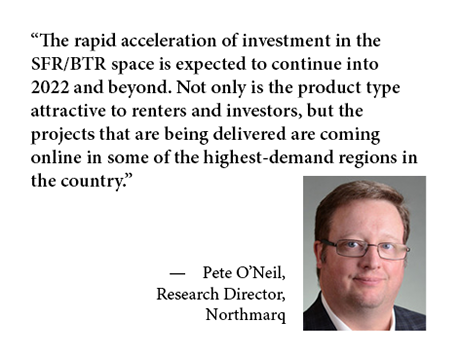Demand for all forms of housing has been on the rise in recent years, a trend that is expected to continue in 2022. One segment of the market that is attracting significant attention is single-family/build-to-rent (SFR/BTR), as a series of economic and demographic shifts increase the attractiveness of an alternative to traditional apartments.
Developers are ramping up activity on thousands of new units, particularly in the high-growth southern U.S. markets. Dozens of projects totaling more than $1.5 billion sold in 2021. Meanwhile, billions of dollars of debt and equity capital continue to move into this increasingly attractive investment class.
Northmarq’s National Multifamily 2022 Outlook covers the record-setting momentum that multifamily properties across the United States saw last year and projects what the market may see in 2022. Northmarq’s full report is available here (with further rundowns on factors like the overall economy, rent trends, the investment market and financing climate). Their analysis on the SFR/BTR market below breaks down the trends and opportunities for growth in this burgeoning sector.
Reasons for Growth
Several factors are prompting the development of SFR/BTR. A primary influence is the changing mix of renters; today’s renters are generally older and more affluent than in the past. These renter households crave the privacy and the added space that single-family housing offers but may not be able to accumulate the down-payment required in a rising and increasingly competitive for-sale housing market.
Single-family homes built specifically as rental communities fill this void. Developers have ramped up activity levels in recent years and will likely complete approximately 60,000 single-family homes as rental units in 2022, up more than 40 percent from levels recorded as recently as 2017.
Southern States are the Focus of SFR/BTR
After the SFR/BTR product first gained widespread popularity in the high-growth Phoenix market, development of new units is being concentrated in the rapidly expanding markets in the southern United States. In 2021, approximately 60 percent of the starts occurred in the South region, up from about 45 percent of the national total a few years ago.
In addition to Phoenix, where an additional 10,000 units are slated to be delivered in the next few years, markets in Texas and North Carolina have the greatest number of projects that are currently under way. Markets throughout Florida and Georgia will gain traction with projects breaking ground throughout the year, although the bulk of the deliveries in these states will likely occur beginning in 2023.
SFR/BTR Trends and Projections
The pace of investment in SFR/BTR communities has been on the rise. Dollar volume more than doubled from 2019 to 2020, before nearly doubling again in 2021. Dozens of projects totaling more than $1.5 billion sold in 2021.
The rapid acceleration of investment in the SFR/BTR space is expected to continue into 2022 and beyond. Not only is the product type attractive to renters and investors, but the projects that are being delivered are coming online in some of the highest-demand regions in the country. Renter demand has topped initial expectations as new communities lease-up quickly. Several institutions are attempting to allocate funds in the single-family rental space, either through developing new projects or acquiring newly constructed properties.
— By Pete O’Neil, Research Director, Northmarq. Northmarq is a content partner of REBusinessOnline. For more articles from and news about Northmaq, click here.
Visit here to read Northmarq’s report, National Multifamily 2022 Outlook.



